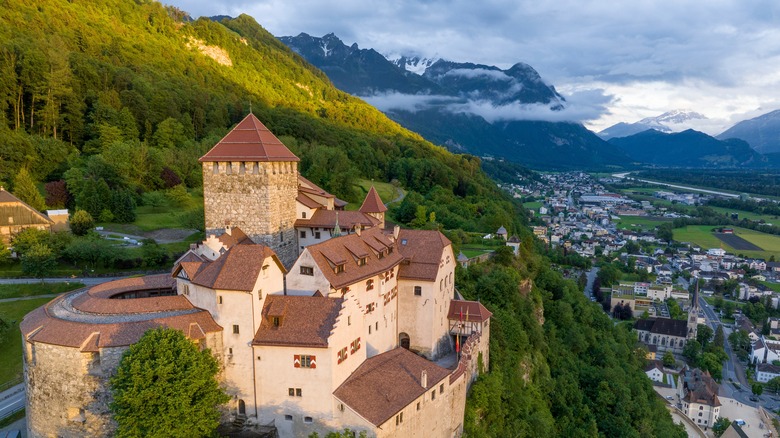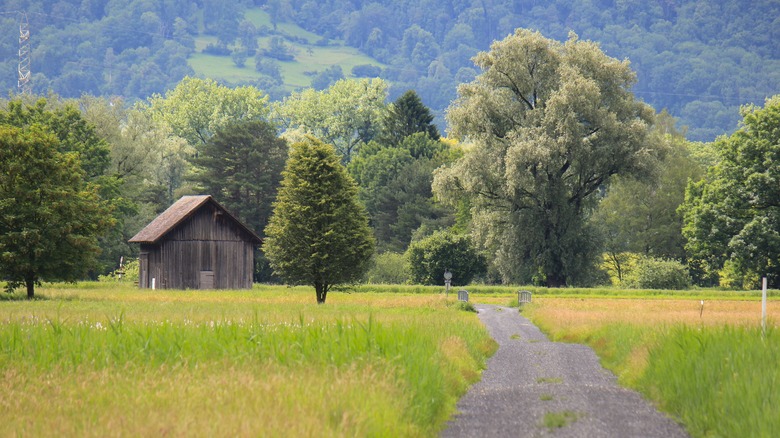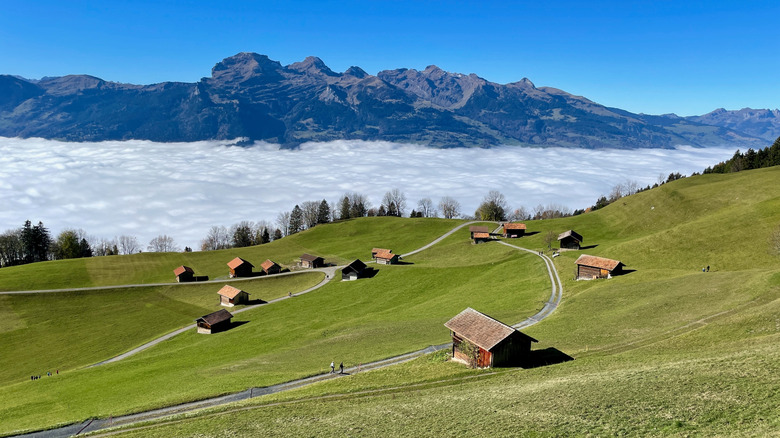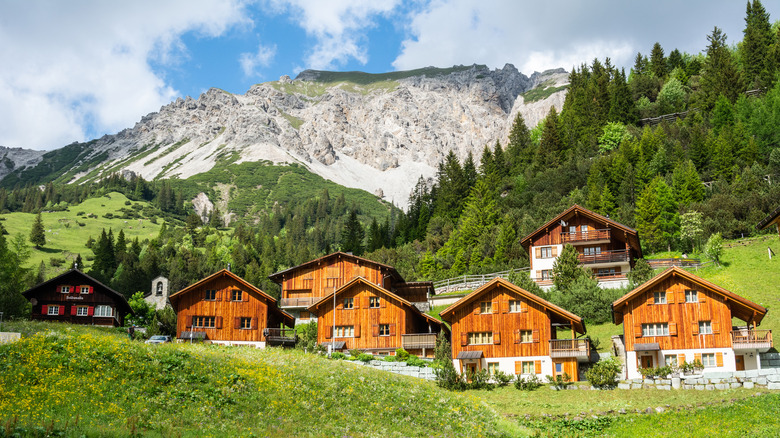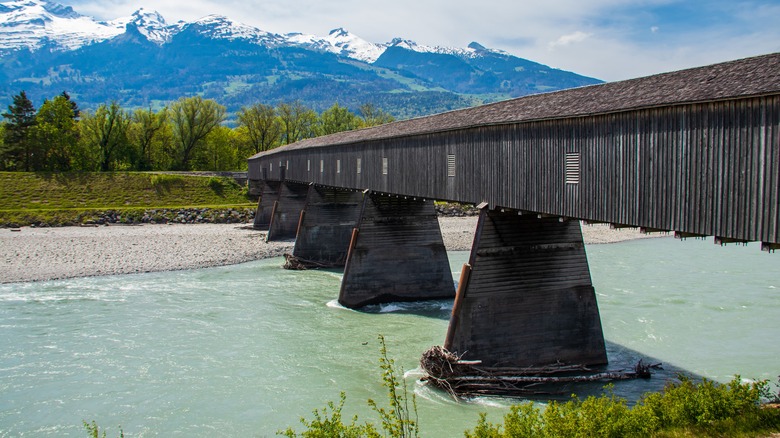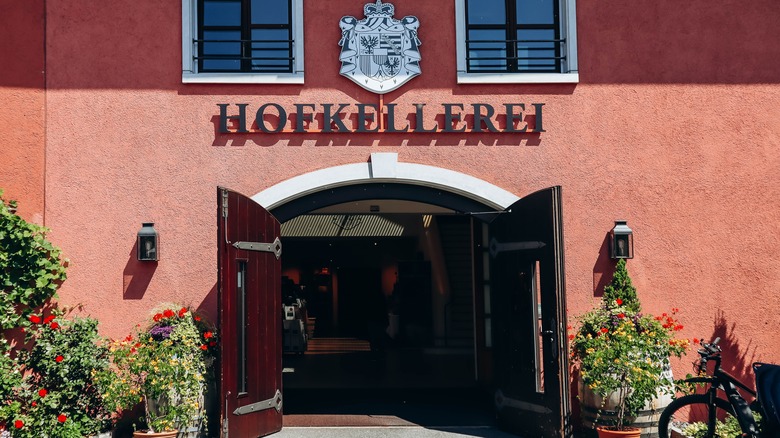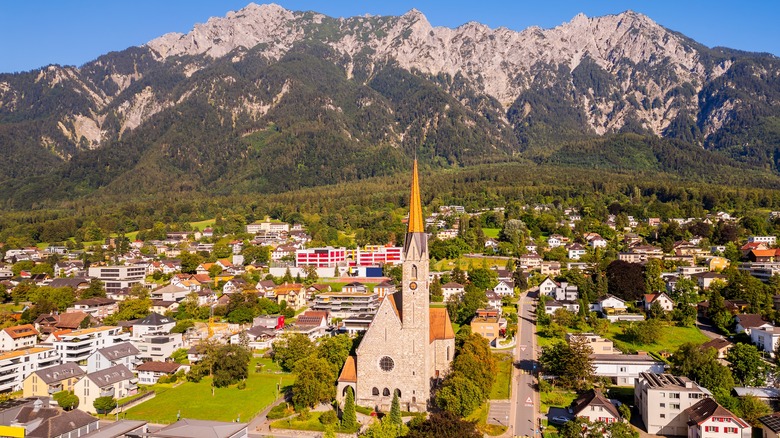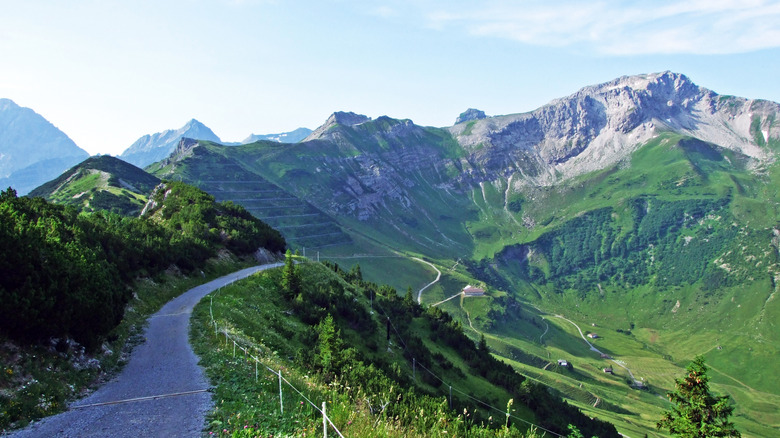Liechtenstein's 11 Must-See Tourist Attractions For Your First Trip
Liechtenstein is one of Europe's true hidden gems. Not only is it one of the smallest countries in the region — it's the same size as Washington, D.C. at just 62 square miles, with a population of around 40,000 — but it's also one of the least visited countries in the world. However, that doesn't mean it doesn't have its fair share of worthy sites. Instead, it just means that you're less likely to have run-ins with fellow tourists than you would in Liechtenstein's more popular neighbors, like Switzerland.
A landlocked country deep in the Alps, Liechtenstein is full of terrain ideal for hiking and skiing. In addition to mountains, the country also boasts deep valleys, a section of the famous Rhine River, and a collection of quintessential Alpine landscapes dotted with both cows and steep-roofed chalets (not to mention the occasional castle).
For this Liechtenstein travel guide, we've compiled a list of the country's 11 must-see attractions you can't miss. Utilizing local sources, travel experts, and traveler reviews, we included historical places, unique destinations, and select locations that truly showcase Liechtenstein's Alpine beauty — including several long-distance hiking trails that traverse the countryside. Together, these highlights will confirm that the sixth-smallest country in the world is definitely worth a visit.
Old Town Vaduz & Schloss Vaduz (Vaduz Castle)
Although Liechtenstein and its capital are both tiny, they're not short on charm. A must-visit is the Old Town, or Städtle, where historic buildings line the streets framed by breathtaking mountains. Notable attractions here include the pyramid-like Parliament Building, the 19th-century St. Florin Cathedral, the Government Building, and Mitteldorf, a small neighborhood known for its traditional facades and roses. Another famous site in Vaduz is the lovely, vineyard-surrounded Rotes Haus ("Red House"), a distinct 12th-century gabled house with a half-timbered tower.
Previous travelers rave about Vaduz Old Town, with several of them highlighting how it's ideal for a pleasant walk. If possible, we also recommend visiting in December, when the town truly comes alive with the spirit of its Christmas markets and decorations.
One of the most iconic tourist attractions in Old Town Vaduz can be found high above the capital. Dating back to the early 1200s, Schloss Vaduz (Vaduz Castle) is the home of the current prince and his family. As a result, tours of the interior are rare — but the grounds are free (and gorgeous) to explore. Located a 10-minute walk from Mitteldorf, you'll be rewarded with views of the fairy-tale turrets, as well as panoramic views of Vaduz and the surrounding mountains. An ideal way to explore both the Old Town and get some incredible castle views — especially for those with limited mobility — is aboard the Vaduz Citytrain Tour, a 35-minute ride on a historical train that showcases the highlights of the city.
The Liechtenstein Trail
One of the least visited countries in Europe, Liechtenstein is so small that you can practically walk across it in one day — or so they say. However, while one day might be a stretch to cover the entire 47-mile Liechtenstein Trail, it's still a joy to spend as much time as possible exploring by foot.The Liechtenstein Trail meanders through all of the country's 11 districts, from the Swiss border to the Austrian border. Hiking the trail is free and doesn't require reservations, and while it technically can be walked in less, it's often divided into five chunks over five days.
Walkable in either direction — from Schaanwald to Balzers or vice versa — it passes through most of Liechtenstein's rural wonders, including Ruggeller Riet, a wetlands preserve, the abandoned Schellenberg castle ruins, and many of the country's most charming towns, like Triesenberg. Specifically, stage one covers 12 miles between Schaanwald and Ruggell, stage two covers 9 miles between Ruggell and Nendeln, stage three covers 11 miles between Nendeln and Vaduz, stage four is 6 miles between Vaduz and Triesenberg, and, finally, stage five completes the trail with a 10-mile jaunt to Balzers.
According to Nicole Thöny, a project manager for Liechtenstein Marketing, in conversation with Afar, the trail has helped increase Liechtenstein's tourism by approximately 30%. That said, it's still unlikely to be crowded. Pro tip: Before setting off, make sure to download the free LIstory app, which details each point of interest along the trail. Also, consider booking a trip with Liechtenstein's travel ministry, which will transport your luggage between stops.
Triesenberg
When you picture a quintessential Alpine village, one like Triesenberg probably comes to mind. Situated high on a lush green hill, the town is surrounded by peaks, filled with wooden houses, and accentuated by a lovely church. Rivaling some of Switzerland's most beautiful villages, Triesenberg was actually established by the German-speaking Walser people, who left Switzerland in the 13th century and settled in the region.
Walser influence is still evident throughout Triesenberg — from the dark chalets to the life-sized wooden statues in the forest, the food, the Walsermuseum showcasing their history, and even the locally-spoken dialect. Make sure to stop by the Walserhaus, a traditionally furnished home, and sample local specialties like ribel, a porridge-like dish made with corn, or a traditional apple donut (öpfelchüachli).
Previous travelers describe Triesenberg as a serene and picturesque mountain village, and they especially recommend meeting the post office dog. As for accommodation, the best way to explore many of the surrounding trails, and Triesenberg itself, is to rent a mountain hut where you can base yourself for a few days. Finally, the town's onion-domed church, with its gorgeous views and a unique all-wood interior, is also a must-see.
Burg Gutenberg
High above Balzers, and visible for miles around, is the iconic Burg Gutenberg. Dating back to the Middle Ages — with evidence of even older settlements — the castle is located just a 20-minute bus ride south of Vaduz in a scenic valley surrounded by steep mountains. Once the home of Egon Rheinberger, local architect who restored the building in the early 20th century, Burg Gutenberg is now a historical landmark.
Although the entire castle isn't open to visitors except during occasional exhibits or events, the outer bailey and inner courtyard are open to the public year-round. Between May 1 and October 31, visitors can also explore the beautiful rose garden every Sunday from 10 a.m. to 5 p.m.
A moderate hike from the bottom is necessary, but breaking a sweat is well worth the effort to soak up the Alpine views once you've reached the top. For even more picturesque vistas, try to plan your visit for sunset, and make sure you save enough time to explore the intriguing cemetery next door.
Malbun
Near Triesenberg and Steg — Liechtenstein's wildly idyllic lakeside mountain village — is Malbun, the country's center for outdoor recreation and its highest town. In the winter, Malbun is the only ski resort in Liechtenstein, transforming into a winter wonderland that's perfect for snow activities. Wooden chalets dot the landscape, while the Sareis Chairlift sweeps skiers and snowboarders up the mountain where they can enjoy miles of pristine slopes. Similarly, cross-country skiers, hikers, or snowshoers can also traverse flatter trails, while younger travelers can sled down the smaller slopes. And once the snow fun is done, everyone can enjoy some deliciously melty fondue.
That said, Malbun's chair lifts don't just get a workout in the winter. In the summer, they also take hikers up to the top, where they can traverse the trails that crisscross the mountains. There's also a lodge at the top of the chairlift serving local specialties with a side of truly stellar vistas, as well as a small playground for the littlest ones in tow.
While Malbun feels like a world of its own at 5,249 feet high, it's actually really easy to reach from Vaduz. To get there, simply follow Liechtenstein's longest road past Schloss Vaduz for about 8 miles, either by car or by hopping aboard one of the regular buses.
The Museum Mile
Museum aficionados might pass over Liechtenstein when considering where to travel in Europe, mistakenly believing this tiny principality doesn't have any world-class museums. However, they'd be wrong. Vaduz's "Museum Mile" is characterized by six unique museums boasting first-rate exhibits including art, history, and unique artifacts.
One of the highlights is the Liechtenstein National Museum, or the Liechtensteinisches LandesMuseum, which offers a thorough history of the country through a series of archaeological, natural, and historical exhibits. Another must-visit museum is the Kunstmuseum Liechtenstein, a strikingly modern building featuring modern and contemporary artwork from the 20th and 21st centuries.
Two more gems of Vaduz's "Museum Mile" are the Schatzkammer Liechtenstein, or the "Treasure Chest," and the very cool Postal Museum. Housed in the same building, the Treasure Chest showcases Liechtenstein's history through its jewels (like the crown jewels) and other riches, while the Postal Museum is home to historic postage stamps, postal equipment, and more.
The Alte Rheinbrücke
The Alte Rheinbrücke, or Old Rhine Bridge, is the only historic wooden bridge remaining that crosses the iconic Rhine River. As the river forms the border between Liechtenstein and Switzerland, the bridge also connects the two countries, making it one of the most unique attractions in the Rhine Valley (the Upper Rhine Valley is home to a part of Liechtenstein).
The structure dates back to 1901, when there were a total of 13 covered wooden bridges in the region. Spanning 443 feet long, the Alte Rheinbrücke stretches roughly 20 feet across the Rhine, still near its headwaters in the Swiss Alps. In essence, it's a treasure of traditional Swiss engineering. As of 1973, the Alte Rheinbrücke is only open to pedestrians and cyclists in order to preserve its integrity. Additionally, a preservation order from Liechtenstein and extensive renovations in 2010 have also been implemented to ensure this last bit of yesteryear should remain for many years to come.
Wildschloss (Schalun Castle)
The ruins of Wildschloss, or Schalun Castle, lie about an hour outside of Vaduz. Hidden high in the mountains, the structure was abandoned and burned down in the 14th century. However, the crumbling walls remain visible and explorable to this day, perched on the edge of a cliff. The best way to access the ruins is via a one-to-two-hour hike from the center of Vaduz, past Schloss Vaduz (stop by for a quick visit, if you want to make it a castle-themed day), and along a slowly ascending cart track.
Along the way, the winding trail provides incredible views of the Rhine Valley and Liechtenstein forests, as well as panoramas of Vaduz and peekaboo views of Wildschloss itself. In addition, you'll also find the occasional informational panel providing details about the country and trail. Before you reach the castle, stop at the viewing platform to take in all its beauty, then continue up to the ruins. There, you can explore freely, soak up the mind-boggling mountain vistas when possible (much is obscured by vegetation), and even start a bonfire at a nearby pit.
Wildschloss is especially intriguing because not much is known about it. No one is sure who built it, why they did, or even when it was built, although archaeological studies have dated it back to the 12th century. While Liechtenstein has other, more well-preserved castles, Wildschloss is unique for its wild beauty and forgotten fairy tale vibes as it juts straight out of the cliff into the sky.
Hofkellerei (Court Winery)
While you can't visit the Prince of Liechtenstein's castle — except on August 15, when the royal family opens the doors of Schloss Vaduz to visitors in honor of Liechtenstein National Day — you can visit his wine cellar. Liechtenstein has a long history of winemaking that goes back at least 600 years, thanks in part to its ideal growing conditions. In fact, the Ancient Romans are said to have cultivated grapes here for wine around 2,000 years ago, utilizing local, wild grape varietals. As a result, you'll see vineyards scattered throughout the country. And one of the best places to sample this delicious local specialty is at the Hofkellerei, also known as the Princely Wine Cellar.
Located just a few minutes' walk from the center of Vaduz, visitors can tour the surrounding, picturesque vineyards, and pop into the historic cellar for a sample (or two). For around $23 per person, guests can take part in the cellar's daily group tastings, which run for about 90 minutes. Alternatively, private tours and tastings are also available for travelers looking for a more intimate experience.
Previous visitors to Hofkellerei especially recommend that you purchase wine by the bottle directly from the cellar, especially considering how affordable these can be. As a tasting tip, it's worth noting that Liechtenstein is particularly known for its Pinot Noirs and Chardonnays. So, if you're a fan of those, go ahead and give them a try. For an even more unique experience, visit in the autumn to take part in one of the country's many seasonal wine festivals.
Schaan
Schaan is one of Liechtenstein's oldest towns, and one of its most picturesque. A true European royal Alpine escape dating back to Roman times, several Roman ruins can be spotted throughout town, along with pastel-colored buildings lining cobblestoned streets. In addition to its varied architecture, Schaan is an ideal base to explore the country because it offers easy access to the mountains, castles, vineyards, and Vaduz (a 15-minute bus ride away). Moreover, the Rhine River is located just outside of town, and the city is lined with cycling routes that lead further out into the countryside.
Schaan is also known for its local markets, which sell everything from local produce to artisan goods. To fully appreciate the town, make sure to follow the Schaan Cultural Trail through the town, which features 21 "stations" or points of interest that will lead you through Schaan's past and present daily life.
That said, one of the highlights of Schaan sits just outside of town at the Freizeitanlage Dux, a forest adventure center located near the Dux Chapel. A large recreation area, the space includes tennis courts, a playground, a ropes course, and a forest play trail. The gorgeous wood-and-glass Tower at Dux, added in 2024, is also a must-see. The sustainably-built tower — a curvy wood structure that soars above the surrounding landscape — is situated below the Three Sisters mountain chain, considered one of Liechtenstein's most iconic trails, and is a unique way to take in the Alpine scenery.
The Eschnerberg Trail
Thanks to its location in the Alps, and with nearly 250 miles of trails, Liechtenstein is home to the densest network of trails in Europe (via Liechtenstein Marketing). In addition to the aforementioned Liechtenstein Trail, another excellent route is the historical Eschnerberg Trail. The 9-mile-long route connects the historic villages of Bendern and Schellenberg, and takes hikers past some of Liechtenstein's most stunning scenery. It also winds past some of two of the country's oldest prehistoric settlements, Lutzegütle and Malanser. Following the Eschnerberg ridge, the trail is lined with occasional informational plaques to provide background on the history and sights you'll see along the way.
One of the highlights of the trail is in the mountains near Schellenberg. The Schellenberg Castle ruins, split into the Upper Castle and the Lower Castle, date back to the 12th century. After they were abandoned in the 16th century, the castle slowly crumbled back into nature and is now a fascinating ruin to explore. The trail ends (or begins, depending on where you depart) in the village of Schellenberg, a charming hamlet that's home to what's believed to be the oldest house in the country.
Methodology
To narrow down our picks of Liechtenstein's top 11 destinations for first-timers, we consulted a variety of travel websites that helped us curate our selection. This included both Liechtenstein-based tourism websites, as well as more general travel-focused, global publications like Wanderlust Magazine, Afar, and Lonely Planet. Ultimately, by carefully selecting destinations that showcase the country's authentic character, we can help travelers avoid overrated tourist hotspots and discover Liechtenstein's true hidden treasures.
Additionally, as there is so much hiking in Liechtenstein, we also sourced data from several specialized hiking websites, including AllTrails, to understand and evaluate all of the different options. Finally, we consulted review and user-driven platforms like TripAdvisor and Reddit to get first-hand recommendations directly from travelers themselves, essentially confirming that these destinations are truly worth experiencing.
